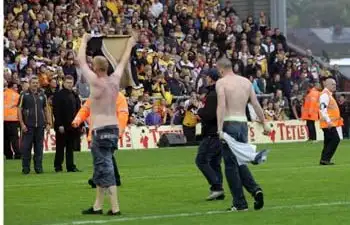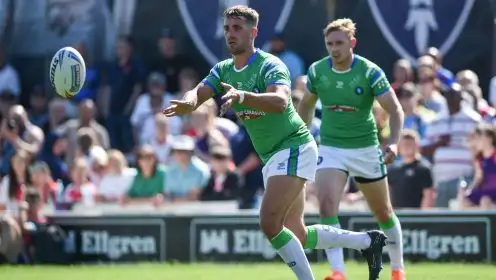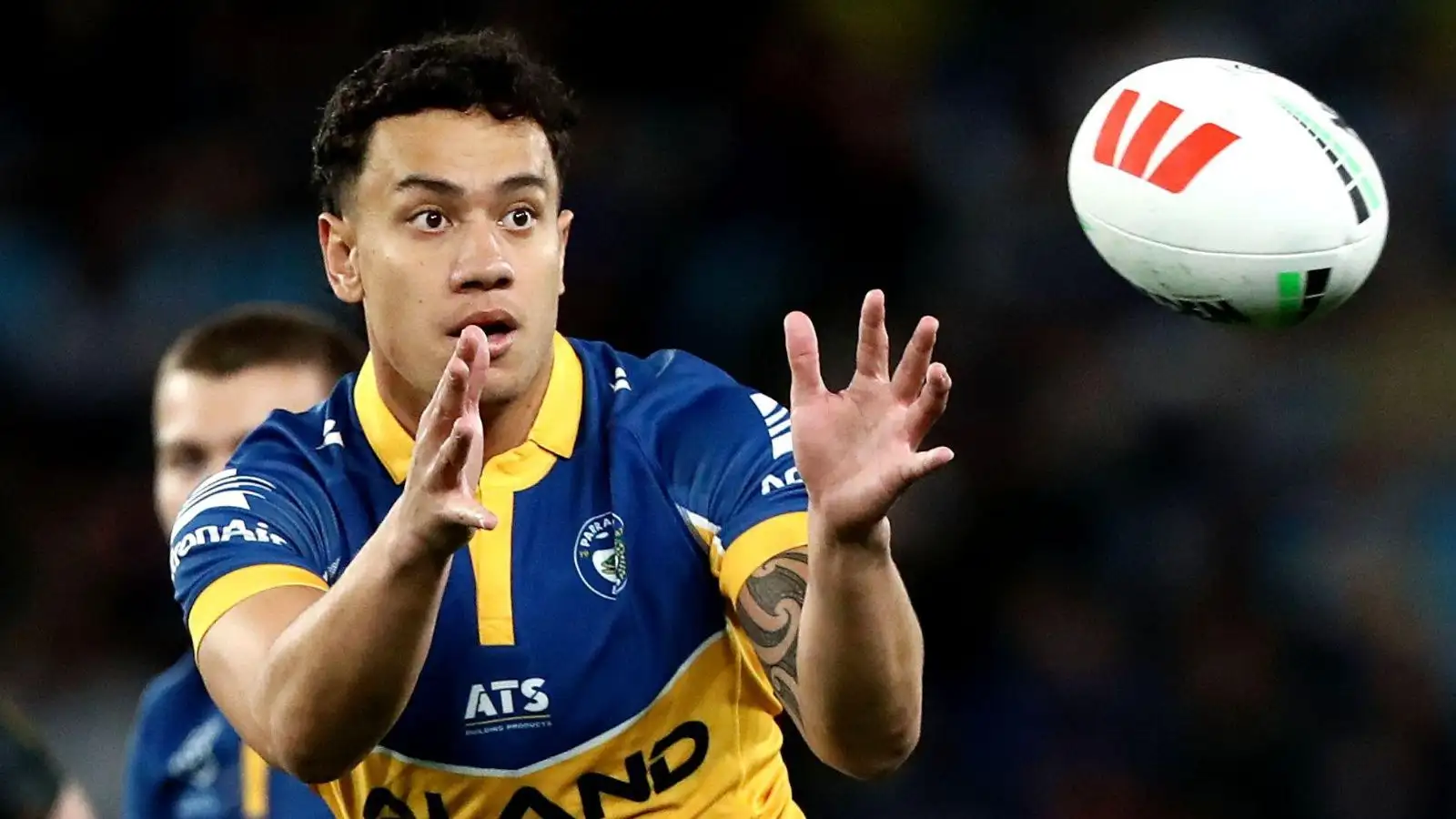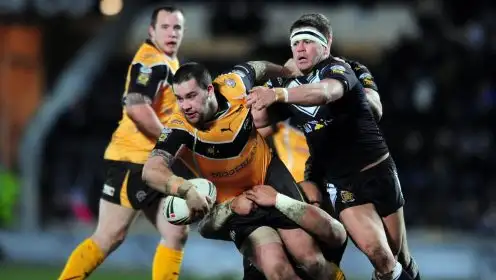Hooliganism: Rugby league lovers must unite against it

Trouble at rugby league matches is nothing especially new, with an incident occurring almost every season since 2000.
The recent scenes at the Million Pound game at Hull KR, with home fans clashing with Salford fans on the field showed that whether we like it or not there is an underlying problem in our game.
The tolerance for anti-social behaviour by certain elements of our crowds is also pretty high from some people, it has to be said.
We rightly pride ourselves on being a ‘family game’ and the number of women and children who attend our matches.
Too many times, appalling behaviour is excused by the old ‘it’s just people having a laugh’ line, which just doesn’t wash.
What seems acceptable to a young male who is eight or nine pints to the good is not often seen as acceptable in a wider context, and there are many who really need to get their heads round this idea, tricky as it often is for people with inadequate levels of maturity.
An internet search will reveal a catalogue of events going back years, with a large number of Super League and Championship clubs involved.
Overseas, there have been terrible scenes in Papua New Guinea recently, where one person died as a result of widespread and aggressive violence, triggered by a coach’s assault on a referee.
That coach received a life ban from all rugby league, and there were a number of public apologies from players, clubs and the authorities.
They reacted with commendable speed and perception, setting a good example, and their issues with violence at sport in PNG are much more serious than ours.
Organised football violence, centred on the wearing of ‘casual’ label clothes, has enjoyed a somewhat quaint, heritage style revival in recent years, without much of the actual violence and disorder which accompanied the original casual movement in the 1980s.
Or, at least, pretending to be a casual has been revived. Most casuals these days have an experience of violence entirely gleaned from movies and hooligan memoirs.
Too many still labour under the notion that an Aquascutum scarf and a Stone Island jacket made you a hard man.
Some younger rugby league fans seem to have cottoned on that low security and segregation at league games gives them an opportunity to play at casuals.
Some groups even have their own social media accounts, laughably aping the behaviour of soccer mobs.
Just as soccer hooliganism is a pretty pale shadow of its former self, so are these types a pale imitation of real football violence.
But the fact that they are there, and exist at all, should concern genuine rugby league fans.
Much used to be made of the fact that back in the ‘good old days’, rugby league crowds policed themselves.
That may have been true to some extent, though, like many stories, there is much less substance to it than many misty-eyed terrace veterans would suggest.
Rugby league crowds back then consisted of large numbers of people who did manual, physically testing work.
They therefore had the phsyical strength to be confident when challenging anti-social behaviour.
That situation doesn’t exist anymore. People are much more sedentary and inactive in their lives, so when a lagered up steroid monster starts being an arse, they simply do not possess the necessary attribites to force them to stop.
But if people were given more confidence by having more proactive stewards around, then they would undoubtedly feel safer.
Most violence at rugby league is of the opportunistic, rather than organised, kind, but that does not mean that it is any less concerning.
What is perhaps more concerning is the seeming reluctance of people to discuss it.
Is this because it will damage our PR in the wider sporting community? Is it because the powers-that-be do not think there is a problem?
Or is it because it might mean the end of drinking alcohol freely at matches?
Something needs to be done. A frank discussion needs to take place.
Already this season in Super League we have seen worrying scenes at the Million Pound game, Hull FC and Warrington fans clashing after a match at the Halliwell Jones Stadium, trouble at the Magic Weekend, the ugly ruckus at Easter a Huddersfield, female Wigan fan being assaulted at the Jungle and a female Wakefield supporter hit by a brick.
Perhaps we can put together some kind of campaign of the likes of ‘No to violence, yes to rugby league.’
We can also introduce life bans for people caught invading pitches and fighting in grounds. Less tolerance is needed for anti-social drunks, and a greater number of properly trained stewards are needed.
The absence of serious security has contributed to rugby league’s unqiue culture, but, as with everything, there are always parasites who look to take advantage.
There is also a burden of responsibility on club owners to act responsibly at all times, and to cooperate fully with authorities.
Salford have been involved in two fairly major incidents this season, suggesting that there is an issue there that needs looking at.
@hullkr_online v @SalfordDevils #MillionPoundGame pic.twitter.com/uFGhd5iPHF
— Andy Priestley (@AndyPriestley95) October 1, 2016
Both Hull clubs have had their troubles in the not-too-distant past and, Saturday at Rovers aside, have largely dealt with the problem well.
Widnes have also been involved in pitch invasions in recent years, and there was a real problem at Featherstone not so long ago, too, which culminated in fighting betwen Fev and Halifax fans.
But all clubs have their idiots, and every rugby league fan has a story of fighting or disorder at at least one game they have been to.
Drunken punch-ups between arguing fans are not uncommon, sometimes between friends or fans of the same club.
Alcohol is obviously a factor. It seems that excessive alcohol consumption is seen as part attending the event by a significant minority of people.
One senses that the reluctance of some to condemn anti-social behaviour has its roots in the idea that being able to drink at sporting events is somehow sacrosanct.
When trouble marred Scottish football on a regular basis in the late 70s, early 80s, fans were banned from even travelling with alcohol with them on a supporters’ bus.
Alcohol is still banned from being sold at Scottish football matches, something which many people want to see end.
Police Scotland do not want it to end, however, which might be significant. The precise terms of the legislation can be read HERE.
What does seem sadly inevitable is that security must be increased at all games, but especially the big, sensitive occasions.
Running on the pitch by fans has to be completely banned, and dealt with by the use of rugby league banning orders, based on the football banning orders which have worked relatively well in soccer.
And we must remind ourselves of the values of the sport we love, and act together. It is a minority of people who go to sport to get out of their skulls and create disorder.
The majority must now work to show that that conduct is entirely unacceptable, and clubs and the governing bodies, whether at Super League or the RFL, must show adequate leadership on the issue.
It can’t be swept under the carpet any longer.



